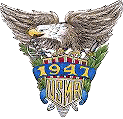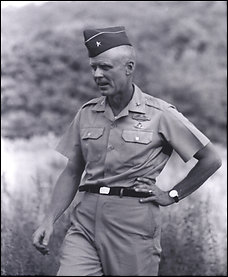Robert Haldane, 83; His Unit Discovered the Cu Chi Tunnels
By Patricia Sullivan
Washington Post Staff Writer
Monday, March 10, 2008
Robert Haldane, 83, an Army officer who led the battalion that discovered the infamous Cu Chi tunnels during the Vietnam War, died of cancer March 5 at his home in Alexandria.
Lt. Gen. Haldane was a lieutenant colonel on Jan. 7, 1966, when he was in charge of the American infantry contingent of the 8,000-man U.S.-Australian Operation Crimp. His troops came under fire as soon as they landed near a rubber plantation about 25 miles northwest of Saigon and were mystified when the large numbers of enemy soldiers seemed to vanish in relatively open terrain.
For three days, the battalion combed the area. They found a large trench, cache after cache of rice and salt, a classroom for 100 men, minefields, foxholes and antiaircraft artillery emplacements. The area was clearly home to a regiment-size force, but few Viet Cong were seen. Yet snipers continually harassed the Americans from within their own lines.
It wasn't until Sgt. Stewart L. Green sat on a nail, which turned out to be attached to a wooden trap door perforated with air holes, that an ingeniously camouflaged tunnel entrance was found. Green, a wiry 130-pound soldier, dropped into the tunnel and reported spotting 30 Viet Cong hiding just feet below the U.S. troops.
Col. Haldane ordered red smoke grenades dropped into the entrance, and within minutes, "reports came in from every direction of red smoke appearing from numerous holes in the ground," according to "Infantry in Vietnam" (1967), edited by Albert N. Garland. The smoke didn't rout the enemy, so Col. Haldane ordered his troops to pump in CS, a nonlethal riot control gas. The Viet Cong stayed put. Finally, Green reentered the tunnel with a demolitions specialist, placed explosive charges and hustled out of the tunnel before the earth exploded.
The tunnels twisted and turned to minimize the effect of explosions and to restrict assaults. They also contained booby traps. Ventilation holes were disguised as anthills. In the tunnels, baskets of grenades hid trap doors to three lower levels. Service records of 148 Viet Cong were found, as well as operating rooms, supply dumps, armories -- everything needed to keep a large fighting force supplied.
The 125 miles of tunnels were later the scene of fierce hand-to-hand combat as American "tunnel rats" fought the Viet Cong in the dark, vermin-infested earth. In Operation Cedar Falls in 1967, 30,000 U.S. troops tried to destroy the tunnels, but historical sources say the Viet Cong used remaining parts of the underground complex as a staging area during the 1968 Tet Offensive. In 1970, B-52s dropped thousands of delayed-fuse bombs that buried deep into the ground before exploding, which finally ended the tunnels' utility. The remnants of the Cu Chi tunnels are now a major tourist attraction in Vietnam.
Even as the tunnels were being discovered, fierce fighting raged in the area. Gen. Haldane was awarded the Silver Star for his actions Jan. 15, 1966, when he rushed an enemy position while under fire to give first aid to wounded troops. The Viet Cong blocked his efforts to evacuate the wounded. His Silver Star citation said that, "armed only with a .45 caliber pistol, Lieutenant Colonel Haldane fearlessly charged the principal Viet Cong strong point, firing his weapon as he ran forward. His dauntless courage inspired his men to complete the assault, and ensured the successful evacuation of the casualties as well as the seizure of the objective."
Gen. Haldane served a second tour in Vietnam in 1968 as commander of the 3rd Brigade of the 1st Infantry Division.
A native of Glen Rock, N.J., Gen. Haldane served in the Army Air Forces in England during World War II. He graduated from the U.S. Military Academy at West Point in 1947 and served in Germany, the United States and Korea before going to Vietnam in 1965.
He graduated from George Washington University with a master's degree in international affairs in 1968. After taking an advanced management course at Harvard University's business school, he became chief of staff for VII Corps in Germany in 1973. He became chief of staff for the Army in Europe in 1978 and chief of staff for the European Command in 1979. He retired in 1982.
Among his military awards were another Silver Star, a Defense Distinguished Service Award, three awards of the Legion of Merit, two Distinguished Flying Crosses and four Bronze Stars.
He was a member and docent at Christ Church in Alexandria. He also volunteered at Knollwood military retirement residence.
Survivors include his wife of 59 years, Elise Frick Haldane of Alexandria; four children, Dorothy Diane Haldane of Baileys Harbor, Wis., Marie Elise Haldane of Washington, David Douglas Haldane of Blue Hill, Maine, and Roberta Bruce Haldane of Canton, N.Y.; and five grandchildren.



